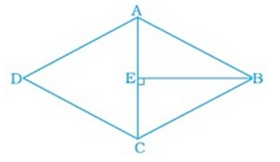8th Grade > Mathematics
MENSURATION MCQs
Total Questions : 57
| Page 3 of 6 pages
Answer: Option D. -> 4:1
:
D
Let the length of one diagonal be x units.
The length of the other diagonal is2x units
Applying Pythagorastheorem,
2×(sideofsquare)2=(lengthofdiagonal)2
⇒(sideofsquare)2
= 12×(lengthofdiagonal)2
Sides of the squares will be √4x22=2x√2
and√x22=x√2
Area of square = (sideofsquare)2
Hence the ratio of the area of squares is (2x√2)2and (x√2)2
= 12×(2x)2:12×x2
= 4: 1
:
D
Let the length of one diagonal be x units.
The length of the other diagonal is2x units
Applying Pythagorastheorem,
2×(sideofsquare)2=(lengthofdiagonal)2
⇒(sideofsquare)2
= 12×(lengthofdiagonal)2
Sides of the squares will be √4x22=2x√2
and√x22=x√2
Area of square = (sideofsquare)2
Hence the ratio of the area of squares is (2x√2)2and (x√2)2
= 12×(2x)2:12×x2
= 4: 1
Answer: Option C. -> Volume of the cylinder will be halved.
:
C
Let us assume the height and radius of the original cylinder is l and r respectively.
Let V1 be the original volume and V2 be the volume after the change in height and radius.
Therefore volume of the original cylinder is given by: V=πr2l
After, height of a cylinder becomes 18of the original height and the radius is doubled
We have, r2=2randl2=l8
So the new volume is given by:
V2=πr22l2=π(2r)2(l8)
⇒V2=4πr2l8
⇒V2=πr2l2=V12
⇒V2=V12
Hence the volume of the cylinder will be halved.
:
C
Let us assume the height and radius of the original cylinder is l and r respectively.
Let V1 be the original volume and V2 be the volume after the change in height and radius.
Therefore volume of the original cylinder is given by: V=πr2l
After, height of a cylinder becomes 18of the original height and the radius is doubled
We have, r2=2randl2=l8
So the new volume is given by:
V2=πr22l2=π(2r)2(l8)
⇒V2=4πr2l8
⇒V2=πr2l2=V12
⇒V2=V12
Hence the volume of the cylinder will be halved.
Answer: Option D. -> 96 cm2
:
D
The diagonals of a rhombus bisect each other. Therefore, in the givenfigure:
⇒BE=DE
⇒BD=2×BE
⇒BD=2×8=16cm
Area of a rhombus equalshalf the product of lengthof the two diagonals.
⇒Area of ABCD= 12×AC×BD
⟹Area of ABCD= 12×12×16=96cm2.
:
D
The diagonals of a rhombus bisect each other. Therefore, in the givenfigure:
⇒BE=DE
⇒BD=2×BE
⇒BD=2×8=16cm
Area of a rhombus equalshalf the product of lengthof the two diagonals.
⇒Area of ABCD= 12×AC×BD
⟹Area of ABCD= 12×12×16=96cm2.
Answer: Option A. -> True
:
A
First, we need to calculate the area of one carpet:
Area of one carpet = 8 ×6 = 48 m2.
Sincetotal area of the floor of the hall = 1200 m2.
Therefore, number of carpets required = areaoffloorareaofonecarpet = 120048 = 25.
:
A
First, we need to calculate the area of one carpet:
Area of one carpet = 8 ×6 = 48 m2.
Sincetotal area of the floor of the hall = 1200 m2.
Therefore, number of carpets required = areaoffloorareaofonecarpet = 120048 = 25.
Answer: Option B. -> B, C, A
:
B
Volume of Cylinder is given by:Vcylinder=π×radius2×height
Volume of Cubeis given by:Vcube=edge3
Volume of Cube is given by Vcuboid=length×breadth×height
Therefore,
⇒Vcylinder=227×r2(2r)=447r3
⇒Vcube=(34r)3=2764r3
⇒Vcuboid=r×54r×73r=3512r3
Comparing the above volumes we get thatVcube <Vcuboid <Vcylinder
:
B
Volume of Cylinder is given by:Vcylinder=π×radius2×height
Volume of Cubeis given by:Vcube=edge3
Volume of Cube is given by Vcuboid=length×breadth×height
Therefore,
⇒Vcylinder=227×r2(2r)=447r3
⇒Vcube=(34r)3=2764r3
⇒Vcuboid=r×54r×73r=3512r3
Comparing the above volumes we get thatVcube <Vcuboid <Vcylinder
Answer: Option C. -> 400
:
C
Volume of one small cuboid= l ×b ×h = 20cm ×25cm ×40cm
Since the edge length of the cubical box = 2 m = 200 cm
Now, Volume of the cubical box = 200cm×200cm×200cm
So the number of cuboids that can be justaccommodated in the box = Volumeofthecubicalboxvolumeofthecuboid.
⇒ Number of cuboids = 200×200×20020×25×40=400
:
C
Volume of one small cuboid= l ×b ×h = 20cm ×25cm ×40cm
Since the edge length of the cubical box = 2 m = 200 cm
Now, Volume of the cubical box = 200cm×200cm×200cm
So the number of cuboids that can be justaccommodated in the box = Volumeofthecubicalboxvolumeofthecuboid.
⇒ Number of cuboids = 200×200×20020×25×40=400
Answer: Option A. -> 256 m2
:
A
Since area of a square has to be calculated, whose diagonal length is 16√2meters. The relation between diagonal and side of a square is :
a√2=d,where, a = side of the square and d = length of diagonal (from Pythagorean theorem)
⇒a√2=16√2
⇒ a=16m.
Therefore, area is given by:
A = a2
⇒A=162=256m2.
:
A
Since area of a square has to be calculated, whose diagonal length is 16√2meters. The relation between diagonal and side of a square is :
a√2=d,where, a = side of the square and d = length of diagonal (from Pythagorean theorem)
⇒a√2=16√2
⇒ a=16m.
Therefore, area is given by:
A = a2
⇒A=162=256m2.
Answer: Option B. ->
25 tiles
:
B
:
B
Number of tiles required
= area of the floorarea of one tile
= (30×50)(10×6)
= 25 tiles
Answer: Option D. ->
48 m2
:
D
:
D
Let the side of a square be 'a' and length and breadth of a rectangle be 'l' and 'b' respectively.
Given,
Perimeter of square = Perimeter of rectangle
4a = 2(l +b)
4 × 8 = 2(12 + b)
32 = 24 + 2b
8 = 2b
Hence b = 4 m
Area of rectangle = l × b = 12 × 4 = 48 m2


















